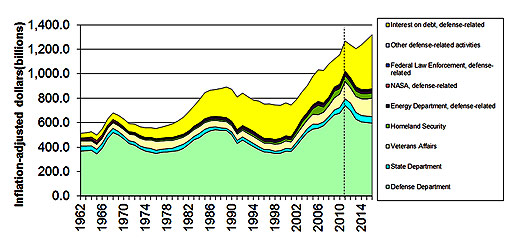
Thinking about U.S. foreign policy these days brings to mind a line from songwriter/comedian Tom Lehrer: if you are feeling like a Christian Scientist with appendicitis you have good reason.
1) The North Atlantic Treaty Organization (NATO) is creating a Rapid Reaction Force to challenge Russian “aggression” in Ukraine, and the U.S., the European Union, and Russia are lobbing sanctions at each other that have thrown Europe back into a recession. Russian planes are buzzing U.S. and Canadian warships in the Black Sea.
2) The U.S. is bombing Iraq and Syria in an effort to halt the Islamic State of Iraq and the Levant (ISIL), while at the same time supporting insurgents trying to overthrow the Assad regime in Damascus, the pool from which ISIL was created.
3) After 13 years of war, Afghanistan is the verge of a civil war over the last presidential election, while the Taliban have stepped up their attacks on the Afghan military and civil authorities.
4) Libya has essentially dissolved as a country, but not without supplying insurgents in central Africa and Nigeria with greatly enhanced firepower.
5) The U.S. encouraged the Japanese government to bypass Article 9 of Japan’s peace constitution that restricted deploying its military outside of Japan. Washington also committed the U.S. to support Tokyo in the event of a clash with China over the ownership of a handful of islands in the East China Sea. American, Japanese and Chinese warships and military aircraft have been playing chicken with one another in the East and South China seas.
What is going on? Did some Pandora open a box she shouldn’t have? Is the Obama administration-take your choice-incompetent? Trying to wind down two of America’s longest wars? Giving liberal cover to a neo-conservative strategy to re-institute a new cold war? Following an agenda?
How about all of them?
There certainly has been incompetence. The 2009 surge into Afghanistan did nothing but kill a lot of people, and the Libya intervention substituted “Chaos Theory” for diplomacy.
It is also true that old wars are winding down. In 2008 there were 110,000 U.S. troops in Afghanistan and 182,000 in Iraq. By the end of 2014 there will be no U.S. troops in Afghanistan, and-at this time-only a handful in Iraq.
Cover for the neo-cons? The Obama administration did help engineer the coup in Ukraine, and Assistant Secretary of State Victoria Nuland-who oversaw the action and handpicked the interim coup president-was Dick Cheney’s principle foreign policy advisor.
And the U.S. certainly has an agenda, which may best be summed up by 19th century British Prime Minister and Foreign Secretary Henry Lord Palmerston-England’s hammer of empire, who oversaw the Opium Wars with China and the Crimean War with Russia: “We have no eternal allies and we have no eternal enemies. Our interests are eternal and perpetual, and these interests it is our duty to follow.”
What are our “interests” in Ukraine?
Certainly not spreading democracy. We supported a coup against a corrupt, but legally elected oligarch, and replaced him with another oligarch in an election that excluded half the country.
There are, in fact, multiple currents at play. During the Cold War disagreements about foreign policy among the ruling elites were suppressed by the overarching need to defeat what was perceived as a real threat to capitalism, the socialist world. “Politics stops at the water’s edge” was the watchword back then. But once that threat evaporated with the collapse of the Soviet Union in 1991, those disagreements were free to come pouring out. Democrats and Republicans now openly sabotage one another’s policies in Asia, Latin America, and the Middle East, and different wings of both parties battle over using the American military.
Which doesn’t mean there isn’t common ground.
One shared interest is pushing NATO east, something the U.S. been doing since the U.S. double-crossed Soviet Prime Minister Mikhail Gorbachev in 1990. Gorbachev agreed to pull 380,000 Soviet troops out of East Germany provided NATO did not fill the vacuum. “Not one inch east,” U.S. Secretary of State James Baker promised. Now, virtually every Warsaw Pact country is a member of NATO.
There is also general agreement-underlined at the recent Alliance meetings in Wales-to expand NATO into a worldwide military alliance, although that creates a certain dilemma for Washington. Currently the U.S. foots 75 percent of NATO’s bill, but is finding that increasingly hard to do, given the enormous costs of the Afghan and Iraq wars, the pivot to Asia, and the expanding war in Iraq and Syria.
The Ukraine crisis has served as the perfect excuse to dragoon other members of NATO into increasing their contributions, though that won’t be a slam-dunk. Most of Europe is in recession, and while the NATO ministers are all for becoming global policemen, their constituents are less enthusiastic. European publics turned sharply against the Afghan War, and most polls show strong opposition to any more “out of area” deployments or increased military spending at the expense of social services.
One strong current at work these days are the neo-conservatives, whose goals are not to just break Ukraine away from Russia, but go for regime change in Moscow. They also lobby for overthrowing the Assad regime in Syria, and for war with Iran. They are overwhelmingly Republicans, but include Democrats.
Allied to the neo-cons in policy-if not politics-are the liberal interventionists, most of whom are Democrats. The interventionists led the charge on Libya and also lobbied for bombing Assad. Former U.S. Secretary of State Hillary Clinton and UN Ambassador Samantha Powers may not have the same politics on all issues as the neo-conservatives, but in places like the Ukraine they share common ground.
A leading “interest” in Ukraine is challenging Russia’s designation as the world’s top energy exporter and throttling its oil and gas industry. With Siberian fields almost tapped out, Russia is developing offshore and arctic sources, and the sanctions are aimed at blocking Moscow from getting the technology it needs to do that. The sanctions are also aimed at the South Stream pipeline, which, when completed, will run from the Caspian basin, across the Black Sea, to Europe. South Stream will eventually supply Europe with 15 percent of its gas and generate $20 billion in yearly revenue for Moscow. The U.S. and Turkey have been trying to derail South Stream for over a decade.
There are minor currents and back eddies as well.
Eastern Ukraine has large shale deposits that Chevron has been sniffing around, and-if you like conspiracies-one of U.S. Vice-president Joe Biden’s kids, Hunter, is on the board of Burisma Holdings, the Ukraine group exploring the country’s energy potentials. Joe Biden has been particularly hawkish on the Ukraine, comparing it to the Munich appeasement with Nazi Germany in 1938.
But the overriding “interest” of American foreign policy-regardless of the different currents-is to marginalize competition. Russia’s economy is no competition for Washington’s, but Moscow is a major supplier of energy to China. The two countries recently inked a $400 billion pipeline deal.
China’s economy is on the verge of passing the U.S. as the world’s largest, and it has already replaced the U.S. as the leading trade partner for most of the world. It is also the globe’s number one consumer of oil and gas.
This latter fact is a sensitive one, particularly given growing tensions between the U.S. and China. Some 80 percent of Beijing’s energy arrives by seas currently controlled by the U.S. Sixth and Seventh fleets.
Russian supplies, however, travel mostly by train and pipelines, and are, thus, out of the U.S. Navy’s reach. China is also negotiating with Iran over energy, and once again, those energy supplies would mostly move through pipelines.
To understand U.S. interests in the Ukraine involves tracking all of these currents, some of which may run at cross purposes. Obama’s push to damage the Russian energy industry is not popular with the American oil company ExxonMobil. He wants to push NATO east, but there is no indication he is seeking regime change in Moscow, and he has even tried to reduce some of the Sturm und Drang around the crisis. The neo-conservatives, on the other hand, want to arm Ukraine and put Putin’s head on a stake.
Of course the “interests” the Obama administration is pursuing in Ukraine are not the “interests” of the majority of Americans-or Ukrainians, for that matter. They are the “interests” of the neo-cons, energy companies, arms manufacturers, and international financial organizations like the International Monetary Fund and the European Bank. In short, the interests of the 1 percent over the 99 percent.
Up until ISIL started cutting American journalists heads off, U.S. polls reflected overwhelming exhaustion with foreign wars. The Center for Public Integrity found 65 percent of Americans would choose to cut military spending. But Americans are also easily stampeded by bombast: The “Russians are coming” (while it was the West that marched east). “Chinese cyber warriors are going to crash our national power grid” (except we don’t have a national power grid and the only countries that have engaged in cyber war are the U.S. and Israel). “And the turbans are going to get you in your bed” (even if U.S. intelligence agencies say the ISIL has not threatened the U.S.).
Since the September 11, 2001 attacks on the World Trade Center and Pentagon, the U.S. has spent almost $70 million an hour on security and around $62 million on domestic needs. Since 9/11 some 23 Americans have died as result of “Muslim terror plots” in the U.S., while the number of those killed by right-wing extremists is 34.
The reality is the U.S. cannot do much about climate change, growing economic inequality, infrastructure deterioration, and the slow motion collapse of our education system without confronting the $1 trillion it spends annually on military and defense related items, or the $4 to $6 trillion that the wars in Afghanistan and Iraq will eventually cost us.
With the U.S. about to begin an open-ended air war in Iraq and Syria (to join those in progress in Pakistan, Yemen and Somalia) the cost of fighting an almost non-existent “terrorist” threat to the U.S. is about to sharply escalate. In whose interest is that?
Increasingly, what is in the interest of the few is incompatible with the interest of the many.
Reposted from Dispatches from the Edge
Graph: The inflation-adjusted defense spending of the United States federal government from 1962 to (forecasted) 2014. It is derived from the FY2012 “President’s budget” Historical tables (Table 3.2-OUTLAYS BY FUNCTION AND SUBFUNCTION: 1962-2014), adjusted using CPI inflation data. Creative Commons Attribution 3.0 Unported.










